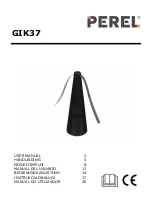
15
13. Frei programmierbare Linearisierung
Mit Hilfe dieser Funktion kann ein linearer
Weg in ein nichtlineares Analogsignal
umgewandelt werden. Es stehen 16
Linearisierungspunkte zur Verfügung, die
über den gesamten Wandlungsbereich in
beliebigen Abständen verteilt werden
können. Zwischen 2 vorgegebenen
Koordinaten interpoliert das Gerät mit
Geradenstücken. Es empfiehlt sich daher,
an Stellen mit starker Krümmung möglichst
viele Punkte zu setzen, wohingegen an
Stellen mit schwacher Krümmung nur
wenige Punkte ausreichend sind.
Um eine Linearisierungskurve vorzugeben,
muß der Parameter „Linearisation Mode“ auf
1 oder auf 2 eingestellt werden.
13. Free programmable linearisation
This programmable feature allows the user
to convert a linear motion to a non- linear
analogue output. There are 16
programmable x/y coordinates available,
which can be set in any desired distance
over the full conversion range. Between
two coordinates, the unit uses linear
interpolation. Therefore it is advicable to
use more coordinates in a range with
strong curves and only a few coordinates
where the curvature is less.
To specify your desired linearisation curve,
you must first set the „Linearisation Mode“
register to either 1 or 2.
Mit den Parametern
P1(x)
bis
P16(x)
geben
Sie 16 x- Koordinaten vor. Das sind die
analogen Ausgangswerte, die das Gerät
ohne Linearisierung in Abhängigkeit der
Geberposition erzeugt. Die Eingabe erfolgt
in Prozent der Vollaussteuerung.
Mit den Parametern P1(y) bis P16(y) geben
Sie nun vor, welchen Wert der Analog-
ausgang an dieser Stelle stattdessen
annehmen soll. Beispiel: der Wert P2(x) wird
dann durch den Wert P2(y) ersetzt.
Wichtig:
•
Die x- Register müssen mit
kontinuierlich ansteigenden Werten
belegt werden, also kleinster Wert in
P1(x), größter Wert in P16(x)
•
Alle Eingaben sind im Format xx,xxx %,
wobei 0,000 % einem Analogausgang
von 0V entspricht und 100,000% der
Vollaussteuerung entspricht.
•
Wenn Linearisation-Mode = 1 gewählt
wurde, muß P1(x) auf 0% und P16(x)
auf 100% gesetzt werden. Die
Linearisierung wird nur im positiven
Wertebereich definiert und bei
negativen Werten wird die Kurve
gespiegelt.
•
Wenn Linearisation-Mode = 2 gewählt
wurde, muß P1(x) auf –100% und
P16(x) auf +100% gesetzt werden.
Damit sind auch Kurven möglich, die
nicht symmetrisch zum Nullpunkt sind.
Use registers P1(x) to P16(x) to specify
the coordinates on the x-axis. These are
the analogue output values that the unit
normally would generate according to the
actual encoder position. These settings
must be in % of full scale.
Now enter the attached values to registers
P1(y) to P16(y). These are the values that
the analogue output will generate instead
of the x- values, i.e. P2(y) substitutes P2(x)
etc.
Important:
•
x-register must use continuously
increasing settings, i.e. P1(x) must
have the lowest setting and P16(x)
must have the highest setting
•
All entries use a percentual format of
xx.xxx% full scale. Setting 0.000%
means zero output and setting
100.000% means full scale output.
•
With Linearisation Mode set to 1, it is
a must to set P1(x) to 0% and P16(x)
to 100%. Linearisation is defined in
the positive range only and the
negative range will be a mirror image
of the positive range.
•
With Linearisation Mode set to 2, it is a
must to set P1(x) to –100% and
P16(x) to +100%. This enables the
user to set curves which are not
symmetric to the zero position.



































